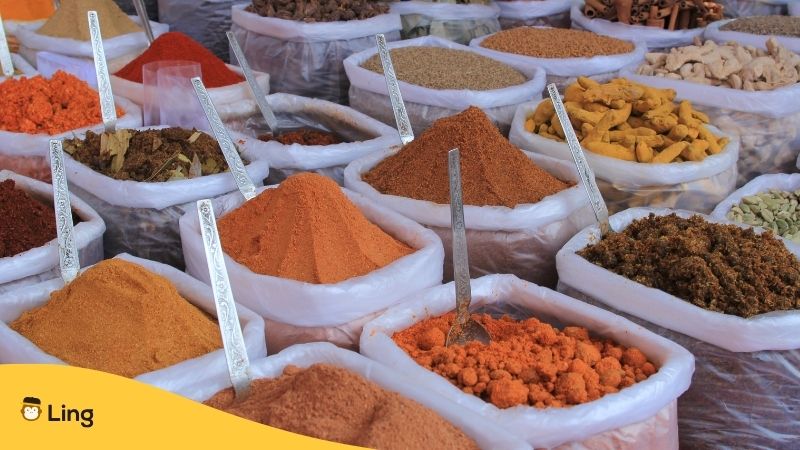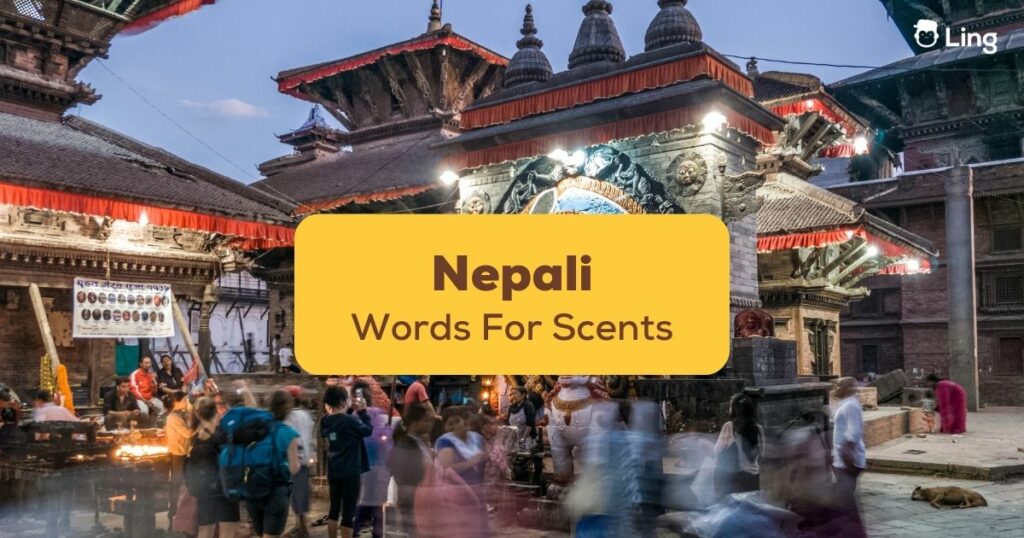Stepping out of the airport in Kathmandu one is immediately met with a barrage of scents and smells at once exotic, alien, and somewhat overwhelming, and in celebration of this redolence, we will be looking at a handful of Nepali words for scents.
From the fragrant rice fields of the Terai plains to the crisp pine mountain air of the Himalayan peaks, Nepal’s vocabulary for scents and smells is as diverse and captivating as its geography. So, here are some words you might find useful when describing the Himalayan nation’s olfactory experiences.
List Of Nepali Words For Scents
In Nepali, the language paints an aromatic palette with words like “सुगन्ध” (sugandha), which signifies a delightful fragrance, and “दाग्रो” (dagro), referring to a pungent or strong odor. These words capture the essence of Nepal’s diverse flora, spices, and cultural rituals, revealing the nation’s olfactory tapestry.
Smell: Gandha (गन्ध)
It seems sensible to start with गन्ध (Gandha), the word for smell in Nepali. It is a versatile term that can be used to describe both pleasant and unpleasant odors and is used as a prefix and suffix to many of the words that describe more particular scents. Whether it’s the intriguing गन्ध of spices in a bustling market or the pungent गन्ध of street-side garbage bins, गन्ध is the catchall Nepali word for the weird and wonderful aromas of Nepal.
Fragrance: Sugandha (सुगन्ध)
In the Nepali language “सुगन्ध” (Sugandha) is the term for fragrance. It encompasses all manner of pleasant scents, from the smell of a fresh cup of morning coffee to the sweet aroma of flowers in bloom and the enticing whiff of freshly cooked street food. In Nepal, the air is often filled with the distinctive odor or सुगन्ध of incense wafting from temples.
Odorless: Gandhahina (गन्धहीन)
Not a word easily found in the Nepali dictionary, गन्धहीन (Gandhahina) means an absence of smell. Not something that is likely to be the case very often in Nepal, the absence of a scent can be just as significant as its presence. गन्धहीन is used to describe something that is odorless or lacks a discernible smell and a term that is especially valuable when discussing clean, pure, or neutral scents, which can be a rarity in a world filled with such a range of intense fragrances filling the air.
Stench: Durgandha (दुर्गन्ध)
Not all scents are pleasant, and for the more offensive odors, Nepali has the term “दुर्गन्ध” (Durgandha). This word is used to describe a strong and unpleasant smell, such as the stink of decaying matter, piles of roadside rubbish, or foul sewage. It is a shame to admit it, but दुर्गन्ध is practically unavoidable if you intend to spend any length of time travelling around Nepal.

Spicy: Masaledara (मसालेदार)
Nepali cuisine is world-renowned for its bold and flavorful spices, and the word “मसालेदार” (Masaledara) describes the spicy scent and taste that characterizes many traditional dishes, whether it’s the pungent aroma of freshly ground spices or the fiery scent of chili peppers. The Nepali meaning of मसालेदार captures the essence of Nepali culinary adventure and is a useful word to have to hand when discussing the menu with the waiter in a restaurant.
Sweet: Mittho (मिठो)
In the world of scents and flavors, “मिठो” (Mittho) is the word for the scent in Nepali that encapsulates sweetness. Whether it’s the alluring aroma of a fresh batch of sweets or the delightful scent of ripe fruits, मिठो transports you to a world of sugary sweetness.
Earthy: Dharati (धरती)
Nepal’s rugged terrain and fertile land give rise to earthy scents and the odor of nature. The word धरती (Dharati) is used to describe these rustic, natural aromas – from the earthy scent of freshly planted rice fields to the odor left by wet soil after a monsoon rain.
Floral: Puspa (पुष्प)
Nepal’s lush landscapes are adorned with an array of vibrant flowers, and the word “पुष्प” (Puspa) is used to describe the floral scents that permeate the air. Whether it’s the delicate fragrance of jasmine चमेली or the intoxicating aroma of rhododendron लाली गुराँस (the national flower of Nepal), पुष्प celebrates the country’s floral scented diversity.

Aromatic: Sugandhita (सुगन्धित)
When a scent is particularly aromatic and pleasing, it can be described as “सुगन्धित” (Sugandhita) in Nepali. This word evokes the idea of an aroma that is not just pleasant but also alluring and captivating, like the scent of incense flowing from temples during religious festivals.
Smoky: Dhuvamyukta (धुवाँयुक्त)
“धुवाँयुक्त” (Dhuvamyukta) in Nepali is used to describe scents that are smoky in nature. It can refer to the smoky aroma of a wood-fired stove, the scent of a bonfire in the mountains, incense in a temple, or the subtle smokiness of certain foods as the ingredients are thrown together in a pot over a cooking fire.
Pungent: Tikho (तिखो)
Spices play a vital role in Nepali cuisine, and “तिखो” (Tikho) is the word used for scent meaning the pleasant pungent reek of spices like chili peppers. Whether it’s the fiery aroma of hot peppers or the sharp scent of black mustard seeds sizzling in a pan, तिखो embodies the inevitable spicy side of Nepali cooking.
Refreshing: Riphresa Gardai (रिफ्रेस गर्दै)
In the high-altitude regions of Nepal, where the air is crisp and invigorating, the term “रिफ्रेस गर्दै” (Riphresa gardai) is used to describe cool or refreshing scents. This word conjures images of the refreshing mountain breeze, the scent of pine forests, or the crisp aroma of pure mountain water.
More Nepali Words For Scents
| English | Nepali | Pronunciation |
|---|---|---|
| Perfume | इत्र | Itra |
| Musk | कस्तुरी | kasturi |
| Incense | धुप | Dhupa |
| Lavender | लैभेन्डर | Laibhendara |
| Vanilla | भ्यानिला | Bhyanila |
| Cinnamon | दालचिनी | Dalchini |
| Rose | गुलाब | Gulab |
| Jasmine | चमेली | Chameli |
| Citrus | सिट्रस | Sitras |
| Sandalwood | चन्दन | Candana |
| Cedar | देवदार | Devdara |
| Pine | पाइन | Paina |
| Eucalyptus | युकलिप्टस | Yukaliptasa |
| Lemon | कागति | Kagati |
Enjoy Learning More Nepali With Ling
Nepali is just one of more than 60+ languages offered by Ling, and as with all of them, Nepali lessons are created by native speakers and Ling provides all the tools needed for you to become proficient in speaking, reading and writing Nepali at a pace that suits you. Try Ling today at Google Play or the App Store.



































































